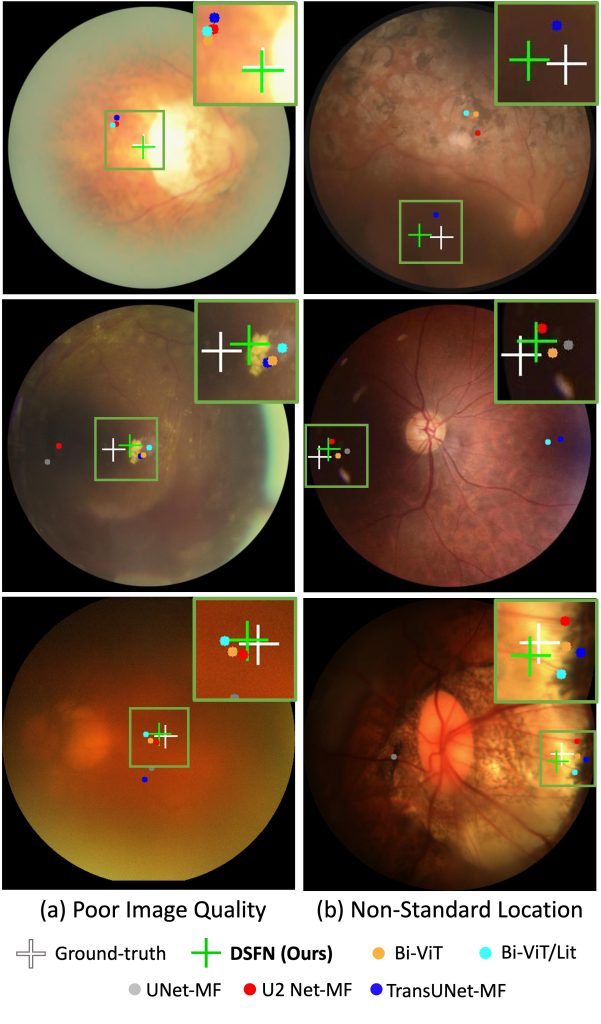12 Sep 2024
Population-based studies have shown retinal disorders are the most common cause of irreversible blindness in developed countries and the second most common cause of blindness after cataracts in developing countries. Medical imaging techniques are key to early detection of retinal disorders, but the technology currently available presents many challenges for practitioners.
To improve the speed and accuracy of diagnoses of retinal disorders, a group of researchers from Xi’an Jiaotong-Liverpool University (XJTLU) and VoxelCloud Inc. in China, has introduced an AI-powered medical imaging technique – DualStreamFoveaNet (DSFN) to address the current imaging challenges.
Dr Sifan Song, a PhD graduate from XJTLU’s School of AI and Advanced Computing and first author of the study, says: “Our new imaging technique, DSFN, has the potential to aids quick and accurate diagnosis of retinal disorders. It also has the potential to be used for other medical conditions that require anatomical structure-based disease diagnosis. For example, in lung cancer screening.”
DSFN combines retina images with vascular distribution information to accurately locate the fovea – a depression at the back of the eye where visual acuity is at its highest - in complex clinical scenarios.
Dr Sifan Song says: “Accurate localisation of the fovea allows medical professionals to detect early signs of ocular diseases, such as tiny changes or deposits in the macular region that surrounds the fovea. This helps to regularly monitor disease progression, evaluate the effectiveness of treatment, or adjust treatment plans, and can prevent retinal disorders that lead to irreversible vision loss.
“However, the current medical imaging techniques for identifying fovea location have many limitations.”
Dr Song explains that the surrounding retinal tissue’s colour intensity makes the fovea’s dark appearance indistinguishable from the retinal background, which is further obscured by retinal diseases.
He emphasises that low light conditions and non-standard fovea locations during photography further challenge accurate fovea localisation.
“Blurred and poorly lit images make visualising the back of the eye difficult and may lead to a misdiagnosis. The DSFN helps to overcome many of these challenges,” Dr Song adds.
 Illustration of the shared global anatomical relationships among the fovea, optic disc, and main blood vessels, in normal (a), diseased (b,c), and poorly conditioned (d) retina images. Credit: XJTLU/IEEE 10.1109/JBHI.2024.3445112
Illustration of the shared global anatomical relationships among the fovea, optic disc, and main blood vessels, in normal (a), diseased (b,c), and poorly conditioned (d) retina images. Credit: XJTLU/IEEE 10.1109/JBHI.2024.3445112
 Comparing visual results of fovea localisation predictions by various methods. Credit: XJTLU/IEEE 10.1109/JBHI.2024.3445112
Comparing visual results of fovea localisation predictions by various methods. Credit: XJTLU/IEEE 10.1109/JBHI.2024.3445112
Dr Song explains the design of DSFN reduces computational costs while maintaining high accuracy, making it more suitable and affordable for application in clinical environments.
“Lower computational costs are accompanied by faster processing speeds, allowing doctors to obtain diagnostic results more quickly and enabling faster model updates and iterations that lead to more accurate predictions of ocular diseases,” says Dr Song.
This work was conducted while Sifan Song is a research internship in VoxelCloud. Dr Song is a postdoctoral researcher working at Harvard Medical School and Massachusetts General Hospital.
The study, DualStreamFoveaNet: A Dual Stream Fusion Architecture with Anatomical Awareness for Robust Fovea Localization, can be read here.
By Haolun Xu
Edited by Catherine Diamond
12 Sep 2024







